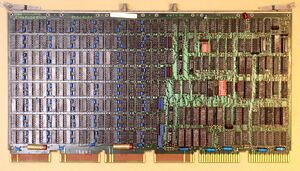Difference between revisions of "MS11-M MOS memory"
(Correct refresh conflict increase) |
m (interleaving cleanup) |
||
| (5 intermediate revisions by the same user not shown) | |||
| Line 1: | Line 1: | ||
| − | + | [[Image:MS11-M.jpg|300px|thumb|right|MS11-M board]] | |
| − | + | The '''MS11-M''' ('''M8722''') is a [[Metal Oxide Semiconductor|MOS]] [[Dynamic RAM|DRAM]] [[main memory]] card; it can theoretically be configured as either [[UNIBUS]] memory, or [[Extended UNIBUS]]. In actuality, the MS11-M uses power [[voltage]]s of +12V/-12V, unlike the normal +15V/-15V supplied by most DEC [[backplane]]s, and thus can be used in only a few installations. | |
| − | When configured | + | When configured for UNIBUS use, it is plugged into an [[Modified UNIBUS Device|MUD]] [[backplane]] slot. '''''Note:''''' a MUD slot does not usually provide +12V/-12V; in general, the MS11-M thus cannot actually be plugged into most MUD backplanes. |
| − | + | When configured as an EUB card, it can only be plugged into the EUB slots on the backplanes of the [[PDP-11/24]] (in the [[BA11-A mounting box]] '''''only''''') and the [[PDP-11/44]], which provide the correct voltages. Configuration is mostly by [[Dual Inline Package|DIP]] switches, along with two [[jumper]]s. | |
| − | + | It has [[Error-correcting code|ECC]] which automagically corrects single-[[bit]] errors, (at a 70 nsec penalty in [[access time|response time]] when an error occurs) and detects double-bit errors. The memory is arranged as 4 banks, each 32 data bits wide, with 7 additional bits for the ECC. On power-on, the system is frozen (via negation of the ACLO UNIBUS signal) for up to 451 msec while the entire memory is cleared, to prevent spurious ECC errors. For [[diagnostic]] purposes, the ECC can be disabled, and there are also means for the CPU to read/write the ECC bits directly. | |
| − | + | The [[access time]] is normally 490-525 nsec (typical/max; 620-675 nsec extra on [[memory refresh]] conflict), and the [[cycle time]] is 950-1000 nsec (write cycle; refresh conflict additional as above). Refresh time is 620 nsec (typical; 675 nsec maximum); the time for a complete refresh pass is 12.5 μsec (typical), or 13.75 μsec (maximum). | |
| − | + | It is a [[DEC card form factor|hex-height]] card; the '''MS11-MB''' holds 256 Kbytes when fully populated with 16Kx1 DRAM [[integrated circuit|chips]]; the half-populated '''MS11-MA''' contains 128 Kbytes. | |
| − | The board has provision to use battery backup power to retain data during a power outage. | + | ==Power== |
| + | |||
| + | Power requirements are 3.8-4.8A of +5V; 1.2-1.5A of +5VBB; 25-50mA of -12V, on pin AS1 (depending on size, i.e. number of MOS memory chips); and .55-1 A of +12V, on pin AR1 (when active; depending on size). Note that if two MS11-M boards are [[memory interleaving|interleaved]], the +12V current draw can be doubled. | ||
| + | |||
| + | The board has provision to use battery backup power to retain data during a power outage. | ||
| + | |||
| + | ==External links== | ||
| + | |||
| + | * [http://bitsavers.org/pdf/dec/pdp11/1144/EK-MS11M-UG-001_UsersMan_May79.pdf MS11-M MOS memory user guide] (EK-MS11M-UG-001) | ||
| + | * [http://bitsavers.org/pdf/dec/pdp11/1144/MP00897_11X44sys_Dec79.pdf 11X44 Field Maintenance Print Set] - the MS11-M Field Maintenance Print Set (MP00742) is on pp. 238-282 | ||
[[Category: UNIBUS Memories]] | [[Category: UNIBUS Memories]] | ||
[[Category: EUB Memories]] | [[Category: EUB Memories]] | ||
Latest revision as of 18:02, 30 July 2023
The MS11-M (M8722) is a MOS DRAM main memory card; it can theoretically be configured as either UNIBUS memory, or Extended UNIBUS. In actuality, the MS11-M uses power voltages of +12V/-12V, unlike the normal +15V/-15V supplied by most DEC backplanes, and thus can be used in only a few installations.
When configured for UNIBUS use, it is plugged into an MUD backplane slot. Note: a MUD slot does not usually provide +12V/-12V; in general, the MS11-M thus cannot actually be plugged into most MUD backplanes.
When configured as an EUB card, it can only be plugged into the EUB slots on the backplanes of the PDP-11/24 (in the BA11-A mounting box only) and the PDP-11/44, which provide the correct voltages. Configuration is mostly by DIP switches, along with two jumpers.
It has ECC which automagically corrects single-bit errors, (at a 70 nsec penalty in response time when an error occurs) and detects double-bit errors. The memory is arranged as 4 banks, each 32 data bits wide, with 7 additional bits for the ECC. On power-on, the system is frozen (via negation of the ACLO UNIBUS signal) for up to 451 msec while the entire memory is cleared, to prevent spurious ECC errors. For diagnostic purposes, the ECC can be disabled, and there are also means for the CPU to read/write the ECC bits directly.
The access time is normally 490-525 nsec (typical/max; 620-675 nsec extra on memory refresh conflict), and the cycle time is 950-1000 nsec (write cycle; refresh conflict additional as above). Refresh time is 620 nsec (typical; 675 nsec maximum); the time for a complete refresh pass is 12.5 μsec (typical), or 13.75 μsec (maximum).
It is a hex-height card; the MS11-MB holds 256 Kbytes when fully populated with 16Kx1 DRAM chips; the half-populated MS11-MA contains 128 Kbytes.
Power
Power requirements are 3.8-4.8A of +5V; 1.2-1.5A of +5VBB; 25-50mA of -12V, on pin AS1 (depending on size, i.e. number of MOS memory chips); and .55-1 A of +12V, on pin AR1 (when active; depending on size). Note that if two MS11-M boards are interleaved, the +12V current draw can be doubled.
The board has provision to use battery backup power to retain data during a power outage.
External links
- MS11-M MOS memory user guide (EK-MS11M-UG-001)
- 11X44 Field Maintenance Print Set - the MS11-M Field Maintenance Print Set (MP00742) is on pp. 238-282
